小学英语人教版第七册阅读课教学设计新部编版
- 格式:pdf
- 大小:364.18 KB
- 文档页数:5
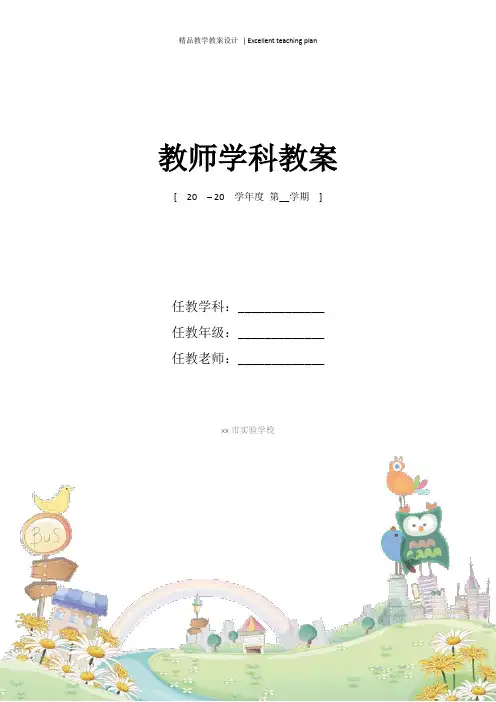
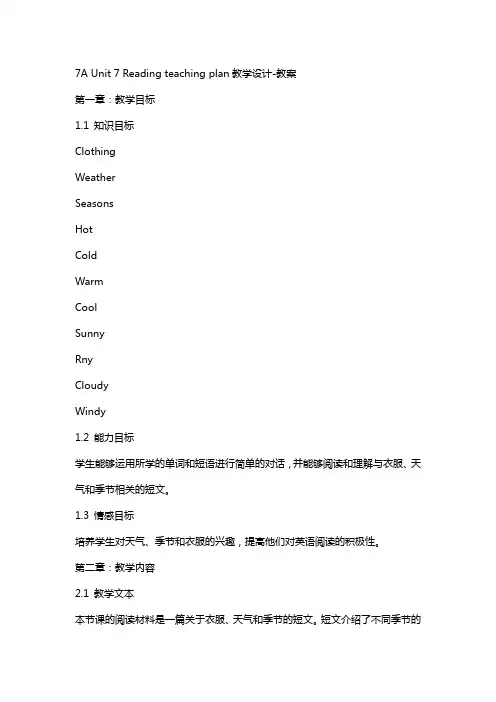
7A Unit 7 Reading teaching plan教学设计-教案第一章:教学目标1.1 知识目标ClothingWeatherSeasonsHotColdWarmCoolSunnyRnyCloudyWindy1.2 能力目标学生能够运用所学的单词和短语进行简单的对话,并能够阅读和理解与衣服、天气和季节相关的短文。
1.3 情感目标培养学生对天气、季节和衣服的兴趣,提高他们对英语阅读的积极性。
第二章:教学内容2.1 教学文本本节课的阅读材料是一篇关于衣服、天气和季节的短文。
短文介绍了不同季节的天气特点以及相应的穿着建议。
2.2 教学重点学生能够理解短文的主要内容,掌握相关的单词和短语,并能够运用它们进行简单的描述和对话。
2.3 教学难点学生能够正确使用一般现在时描述天气和季节的特点。
第三章:教学步骤3.1 导入教师通过提问方式引导学生思考衣服、天气和季节之间的关系,激发学生的学习兴趣。
3.2 阅读理解学生独立阅读短文,回答相关问题。
教师引导学生关注短文中的关键词汇和短语,并解释它们的意思。
3.3 词汇学习教师展示单词和短语的图片,学生跟读并模仿。
教师给出例句,学生模仿并运用这些单词和短语进行描述。
3.4 对话练习学生分成小组,根据短文内容编写对话,并表演给其他小组观看。
教师给予评价和指导。
第四章:作业布置学生回家后,用所学的单词和短语写一篇关于自己喜欢的季节的短文,并画出相应的图片。
第五章:教学反思教师在课后对自己的教学进行反思,考虑学生的学习效果和教学方法的适用性,以便在今后的教学中进行改进。
第六章:教学资源6.1 教学图片教师准备与衣服、天气和季节相关的图片,用于辅助教学和激发学生的兴趣。
6.2 教学音频教师准备与课程内容相关的音频材料,用于播放和模仿。
6.3 教学视频教师准备与课程内容相关的视频材料,用于播放和讨论。
第七章:评价方式7.1 课堂参与度教师观察学生在课堂上的参与程度,包括发言、模仿和对话表演等。

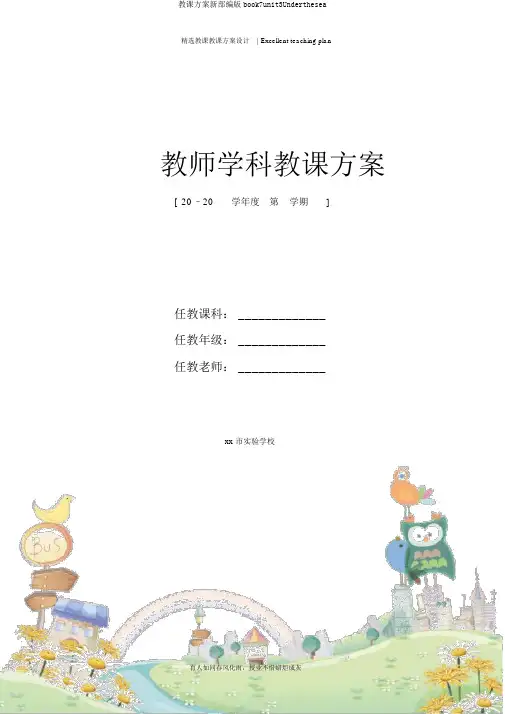
精选教课教课方案设计| Excellent teaching plan教师学科教课方案[ 20–20学年度第__学期]任教课科: _____________任教年级: _____________任教老师: _____________xx市实验学校NameTeaching aims(教课目的 )Important point(教课要点 )Difficult points(教课难点 )Teaching methods (教课方法 ) Teaching aids(教课工具 )Teaching procedures(教课过程 )精选教课教课方案设计| Excellent teaching planThe Teaching Plan (教课方案)Teaching Contents Unit 3 Under the Sea(Reading)1.Knowledge and Ability①Get students to know two anecdotes about whales and humans.②Try to retell the first anecdote.2.Emotional aims (德育目标)①Motivate students to learn English hard.②Arouse students’sense of protecting endangered animals.1.Let students understand the whole passage and find the main idea.2.Summarize the two anecdotes.Let students understand and retell the reading passage.1. Task-based teaching method 3. Teamwork2.Learning plan methodBlackboard, PPT, textbooks, learning planStep 1. Lead –inStep 2. Listening and UnderstandingStep 3. ReadingStep 4. post-readingStep 5. DiscussionStep 6. Homework精选教课教课方案设计| Excellent teaching planUnit 3 Under the sea (Reading)教案Learning aims: (学习目标 )1.Get to know some animals that live under the sea.2.Get to know two anecdotes about whales and humans.Learning important points: (学习要点 )1.Understand the whole passage and find the main idea.2.Summarize the two anecdotes in proper ways on their own. Learning difficult point:(学习难点 )How to retell the passage.Learning method:(学习方法)TeamworkLearning Procedure: (学习步骤 )Step1: Lead –inWhat can you see in the picture? What do you think is happening?The ____________ are helping the________ catch the_____________Read the introduction on Page19 and find the background information. WriterOccupation/ JobWriting styleTimePlaceMain charactersMain ideaStep 2: Predicting1.What is the main idea of the first anecdote?A.About a hunting experience of old Tom.B.About how the killer whales help the whalers to hunt a whale.C.About how the whalers killed Old Tom.D.About how the killer whales killed the whales.2.What’ s the main idea of thesecond anecdote?A. About how Old Tom protected and saved JamesB. About how Old Tom killed a shark.C. About how a shark attacked James.D. About how a shark killed Old Tom.Step 3: ReadingRead the first anecdote and answer the following questions.1. How did the killers help the whalers?Before the hunt The killer whale threw itself out of the _____ and then( Para 1— Para 6)_______ down again,in order to tell the whalers therewas about to be a ________ out there for us.It swam by the_____, showing the whalers the way.During the hunt The killers were working as a _____.( Para 7— Para 9)Some were throwing themselves on ___ of the whale’ s_______ to stop it _________. Others were stopping it_______ or _________ out to sea.After the hunt The killers _______ the dead body down into the ______ of( Para 10—Para 12)the sea, having a good feed on its lips and ______ .2.Retell the first anecdote according to the key words.3.The summary of first anecdote:Old Tom ________ itself ____ ___ the water and _________down again to showthat there was a ________ there. He _________ by the boat, _________ us the ____.As we got closer, I could see a baleen whale ______ ________by a pack of about sixother killers. They were working as a______. The killers stopped it ________. And others were stopping it ______ __ _____.The man used the _________to hit it. The killer whales ________ the whales into the depth of the sea and have a good _____on its tips and tongue.Read the second anecdote and answer the following questions.1. Which was Not the danger James faced?A. being washed off the boat.B. being carried away by rough waves.C. a shark out there.D. being attacked by another killer whale.2.How did Old Tom help James? Why do you think he did this?___________________________________________________________________ ___________________________________________________________________ 3.The summary of second anecdote:One day, James was _________the boat. The sea was _____. The waves were __________ him ________ and _________.James was very _______ of being____________ It took over ____ __ ______to get the boat back to James. And when we ___________him, I saw him ________ ________up in the water by Old Tom.Step 4: Post-readingTrue or False1.Clancy believed that the killers would help the whalers catch whales at first. ( )2.The killer whale is fish-shaped. ()3.The killers worked as a team. ()4.The whalers lost the whale at last. ( )5.Killer whales always harm and attack people. ( )Step 6: Discussion (德育教育 )What should we do to protect the endangered sea species?Step 7: HomeworkTry to retell the second passage according to the key words.高考链接:1.The author mainly tells us in the text that the killer whalesA. are easily trainedB.can help the whalers catch whales and protect peopleC. kill the whales for foodD. are cruel to other whales2.At first, it was ________ that told the whalers there was awhale there and showed the way.A. George B.Old Tom C. the writer D. James3. _____ killed the whale at last.A. Old TomB. The killer whalesC. The authorD. The whalers4.Which of the following is the right order according to the text?a.The killers were working as a team to attack the whale.b.The dead whale was dragged by the killers into the depths of the sea.c.We jumped into the boat with the other whalers.d.The harpoon hit the whale.A. c—a—d—b B.b—a—d—c C. c— d— a—b D.d—a—c—b。
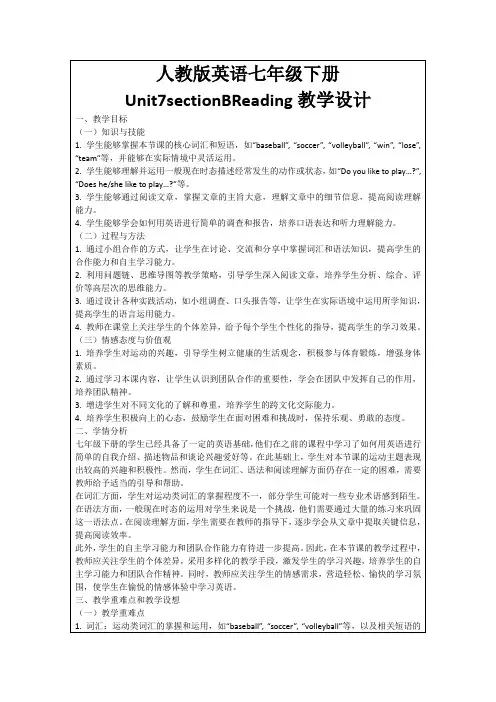
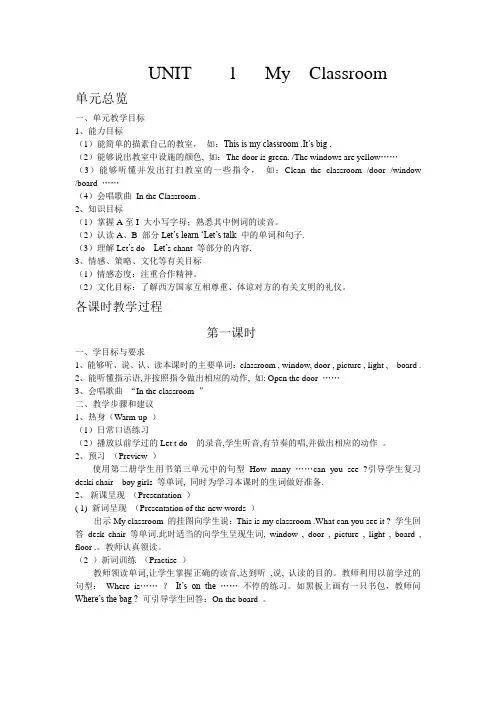
UNIT 1 My Classroom单元总览一、单元教学目标1、能力目标(1)能简单的描素自己的教室,如:This is my classroom .It’s big .(2)能够说出教室中设施的颜色, 如:The door is green. /The windows are yellow……(3)能够听懂并发出打扫教室的一些指令,如:Clean the classroom /door /window /board ……(4)会唱歌曲In the Classroom .2、知识目标(1)掌握A至I 大小写字母;熟悉其中例词的读音。
(2)认读A、B 部分L et’s learn ‘Let’s talk 中的单词和句子.(3)理解Let’s do Let’s chant 等部分的内容.3、情感、策略、文化等有关目标(1)情感态度:注重合作精神。
(2)文化目标:了解西方国家互相尊重、体谅对方的有关文明的礼仪。
各课时教学过程第一课时一、学目标与要求1、能够听、说、认、读本课时的主要单词:classroom , window, door , picture , light , board .2、能听懂指示语,并按照指令做出相应的动作, 如: Open the door ……3、会唱歌曲“In the classroom ”二、教学步骤和建议1、热身(Warm-up )(1)日常口语练习(2)播放以前学过的Let t do 的录音,学生听音,有节奏的唱,并做出相应的动作。
2、预习(Preview )使用第二册学生用书第三单元中的句型How many ……can you see ?引导学生复习deski chair boy girls 等单词, 同时为学习本课时的生词做好准备.2、新课呈现(Presentation )( 1) 新词呈现(Presentation of the new words )出示My classroom 的挂图向学生说:This is my classroom .What can you see it ? 学生回答desk chair 等单词.此时适当的向学生呈现生词, window , door , picture , light , board , floor .。
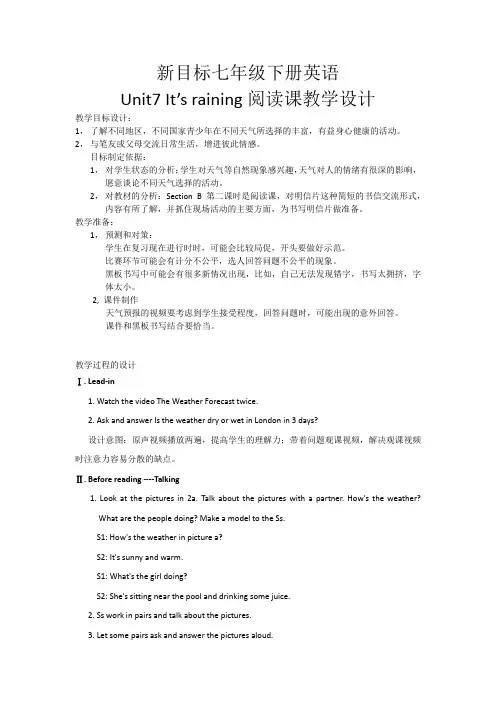
新目标七年级下册英语Unit7 It’s raining阅读课教学设计教学目标设计:1,了解不同地区,不同国家青少年在不同天气所选择的丰富,有益身心健康的活动。
2,与笔友或父母交流日常生活,增进彼此情感。
目标制定依据:1,对学生状态的分析:学生对天气等自然现象感兴趣,天气对人的情绪有很深的影响,愿意谈论不同天气选择的活动。
2,对教材的分析:Section B 第二课时是阅读课,对明信片这种简短的书信交流形式,内容有所了解,并抓住现场活动的主要方面,为书写明信片做准备。
教学准备:1,预测和对策:学生在复习现在进行时时,可能会比较局促,开头要做好示范。
比赛环节可能会有计分不公平,选人回答问题不公平的现象。
黑板书写中可能会有很多新情况出现,比如,自己无法发现错字,书写太拥挤,字体太小。
2, 课件制作天气预报的视频要考虑到学生接受程度,回答问题时,可能出现的意外回答。
课件和黑板书写结合要恰当。
教学过程的设计Ⅰ. Lead-in1. Watch the video The Weather Forecast twice.2. Ask and answer Is the weather dry or wet in London in 3 days?设计意图:原声视频播放两遍,提高学生的理解力;带着问题观课视频,解决观课视频时注意力容易分散的缺点。
Ⅱ. Before reading ----Talking1. Look at the pictures in 2a. Talk about the pictures with a partner. How's the weather?What are the people doing? Make a model to the Ss.S1: How's the weather in picture a?S2: It's sunny and warm.S1: What's the girl doing?S2: She's sitting near the pool and drinking some juice.2. Ss work in pairs and talk about the pictures.3. Let some pairs ask and answer the pictures aloud.设计意图:以比赛的形式复习学过的天气和正在做什么,提高学生观察图片的能力,口语交际的能力。
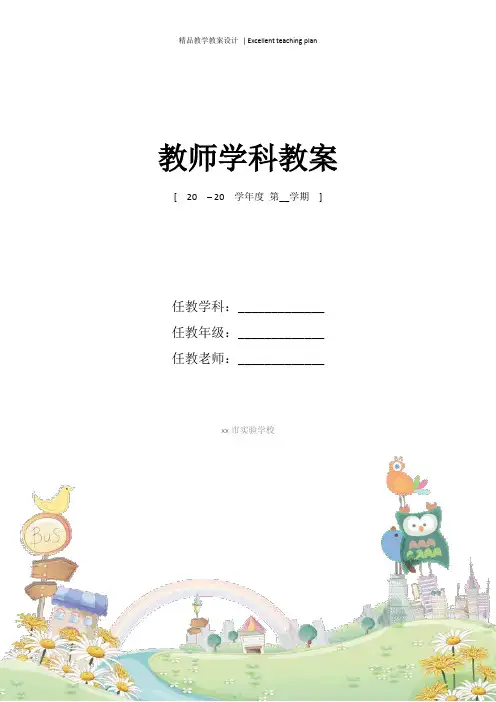
教师学科教案[ 20 – 20 学年度第__学期]任教学科:_____________任教年级:_____________任教老师:_____________xx市实验学校The Teaching Plan(教学设计)Unit 3 Under the sea (Reading) 学案Learning aims:(学习目标)1.Get to know some animals that live under the sea.2. Get to know two anecdotes about whales and humans.Learning important points:(学习重点)1.Understand the whole passage and find the main idea.2. Summarize the two anecdotes in proper ways on their own.Learning difficult point: (学习难点)How to retell the passage.Learning method: (学习方法)TeamworkLearning Procedure: (学习步骤)Step1: Lead –inWhat can you see in the picture? What do you think is happening?The ____________ are helping the________ catch the_____________Read the introduction on Page19 and find the background information. WriterOccupation/ JobWriting styleTimePlaceMain charactersMain ideaStep 2: Predicting1. What is the main idea of the first anecdote?A. About a hunting experience of old Tom.B. About how the killer whales help the whalers to hunt a whale.C. About how the whalers killed Old Tom.D. About how the killer whales killed the whales.2. What’s the main idea of the second anecdote?A. About how Old Tom protected and saved JamesB. About how Old Tom killed a shark.C. About how a shark attacked James.D. About how a shark killed Old Tom.Step 3: ReadingRead the first anecdote and answer the following questions.1. How did the killers help the whalers?2.Retell the first anecdote according to the key words.3.The summary of first anecdote:Old Tom ________ itself ____ ___ the water and _________down again to show that there was a ________ there. He _________ by the boat, _________ us the ____. As we got closer, I could see a baleen whale ______ ________by a pack of about sixother killers. They were working as a______. The killers stopped it ________. And others were stopping it ______ __ _____.The man used the _________to hit it. The killer whales ________ the whales into the depth of the sea and have a good _____on its tips and tongue.Read the second anecdote and answer the following questions.1. Which was Not the danger James faced?A. being washed off the boat.B. being carried away by rough waves.C. a shark out there.D. being attacked by another killer whale.2. How did Old Tom help James? Why do you think he did this?___________________________________________________________________ ___________________________________________________________________ 3. The summary of second anecdote:One day, James was _____ ____the boat. The sea was _____. The waves were __________ him ________ and _________.James was very _______ of being ____________ It took over ____ __ ______to get the boat back to James. And when we ___________him, I saw him ________ ________up in the water by Old Tom. Step 4: Post-readingTrue or False1. Clancy believed that the killers would help the whalers catch whales at first. ( )2. The killer whale is fish-shaped. ( )3. The killers worked as a team. ( )4. The whalers lost the whale at last. ( )5. Killer whales always harm and attack people. ( )Step 6: Discussion (德育教育)What should we do to protect the endangered sea species?Step 7: HomeworkTry to retell the second passage according to the key words.高考链接:1.The author mainly tells us in the text that the killer whalesA.are easily trainedB.can help the whalers catch whales and protect peopleC.kill the whales for foodD.are cruel to other whales2.At first, it was ________ that told the whalers there was a whale there and showed the way.A.George B.Old Tom C.the writer D.James3. _____ killed the whale at last.A. Old TomB. The killer whalesC. The authorD. The whalers4.Which of the following is the right order according to the text?a.The killers were working as a team to attack the whale.b.The dead whale was dragged by the killers into the depths of the sea.c.We jumped into the boat with the other whalers.d.The harpoon hit the whale.A.c—a—d—b B.b—a—d—c C.c—d—a—b D.d—a—c—b。
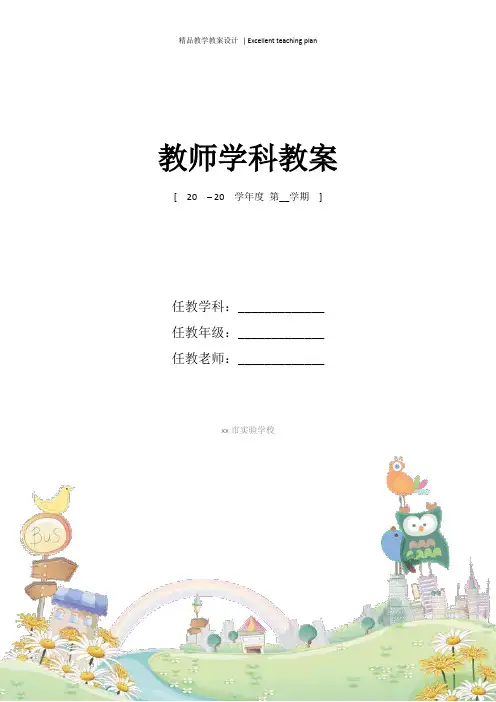
教师学科教案[ 20 – 20 学年度第__学期]任教学科:_____________任教年级:_____________任教老师:_____________xx市实验学校Unit 7 How much are these socks?·Teaching aims:1. knowledge objectives:1) Vocabulary:much, How much…, sock, T-shirt, shorts sweater, sweater, trousers, shoe, skirt, dollar, big, small, short, long, woman, need, look, pair, take.2).Target language:How much is the blue T-shirt?It’s seven dollars.How much are these socks? They are two dollars.Can I help you? Here you are. I’ll take i t/them.2. Ability objectives: Encourage students learn to ask and answer the price of the things.3. Emotion objectives: To cultivate the cooperation through peer interaction. It’s not polite to ask the price of others’ things and incomes.·Teaching and learning methods: guiding for learning.·Teaching aids: multi-media·Key Points:How much questions·Difficulties:The names of different clothes. Demonstratives this, that, these, those.·Teaching procedures:Section APeriod 11a. This activity provides guided pronunciation practice1.Take out some clothes such as socks, shorts, sweater etc. Teach students the pronunciation of those clothes and repeat for times. Let Ss read the new words aloud individually or in pairs2.Take out the cards with clothes names, ask several students to match the correct names carks with the clothes. Other students finish activity 1a.Then check answers.3. Point to the each of the clothes , ask students read out its name quickly.1b. This activity provides listening practice using the target language.4. Play the recording the first time. Students only listen.5. Play the recoding a second time. Ask Ss to circle the names of the things they hear in the picture in6. Point out the list of clothes in 1a. Let Ss circle the names of the clothes the people are talking about.7.Check the answers.1c. This activity provides guided oral practice using the target language.8. show the Tape script on the screen. Point out the conversations on the screen and ask students to read after the tape, then practice in pairs, in groups for competition.9. Ask various pairs to present a new one to the class.Homework: memorize all the new words we’ve learnt today.Summary:Period 22a This activity provides listening and reading practice.1. Show students the different clothes in 8 colors. Ask students to say out the eight colors. Review the words by listening and repeating after the tape. Then present the words big, small, short and long by two caps and two T-shirts. Ask students to repeat the adjectives.2.2b Listening and circling.“ Now look at the six pictures in 2b. We shall listen to six conversations about them. Listen carefully and circle the picture of the article of clothing the person is talking about.” Then Check the answers3.2c. Listening and filling This activity provides listening practice using the target language.Call attention to the numbers, colors and clothes.4. Play the recording again. Ask students to fill in the price tags.5. Check the answers.2d. Asking and answering. This activity provides listening and speaking practice using the target language.Ask students to repeat the how much questions, then show the clothes with price tags, make them to ask and answer.2e.Role-play. This activity provides guided oral practice using the target language.6. show the Tape script on the screen.. Call attention to the conversation on the screen.7. Ask two Ss to read it to the class.8. Ask Ss to work in small groups. Appoint a leader. Make sure everyone talks about at least one of the people on the screen.9. Ask pairs of Ss to present their conversations to the class.Homework:Make sure you’ve mastered all the new words today. Practice the conversation with your partner after class.Summary:Reflection:Period 3I、Teaching aims and demands:Knowledge aims:1. Let the students master colors and clothes.2. Learn how to ask the prices.Ability aims:Enable the students to talk about the prices with how much and to be a polite shopper in an English way.Moral aims:The content of this unit is close to the students’ life, so it will attract students easily and inspire them to fall interest in learning English. And it can also get students to learn how to say thanks to others by practicing conversations about shopping.II、Teaching difficulties and key points.1. How much is this? It’s……How much are these? They’re……2. Item of clothes, colorsIII、Teaching procedures:Step 1.Showing the teaching aims.Step 2. Leading in.Ask: Have you gone shopping? Then say: There is a store. There are many nice clothes in it. Let’s have a look!Step 3.Presentation.1.3a Make sentences in the chart with the words in the three boxes.2.3b Look at the picture and write the questions and answers.3. Then act out a shopping dialogue in a store, play the roles of both customers and the salesperson. Let Ss practice the similar dialogue. Then act it out.Step 4.The memory game.If there is time, play the game in class.Student A, look at the pictures in 3b for a minute and then close your book. Student B, ask questions.Step 5. HomeworkPractice grammar focus.Period 4I、Teaching aims and demands:1. The numbers in English.2.Listening and practicing.II、Teaching properties:Overhead objects, Tapes, Some Cards with numbers on them.III、Language Focus:1.The numbers ten through thirty-one2.Talking about the prices.IV、Teaching Steps:Step 1: GreetingsGreetings to the Students.Step 2: Revision1.Show some objects with price tags. Ask students to work in pairs like this:A: How much are the blue trousers?B: They are $82.Show more clothes the price above ten.Point out the numbers ten through ninety.Step 3: Listening and repeating1.Listen to the tape of la. First time, just listen, then play it several times and ask Students to repeat.2.Ask Students to make some cards with numbers, then work in pairs.3.Listen to 1c. Listen and circle the numbers in la that you hear.4.Listen to 1d. Listen again. Circle the things in the picture that Kate and her mom talk about. Check the thing Kate buys.5.Look at lb. Ask a Students to read the words, the others write a number from the box next to the Correct words below, then find out which two rows of numbers are in the wrong place.6. Show time. According to 1d, ask students make conversations. Then act them out.Step 4: Exercise in class1.Listen and fill. Listen to a dialogue and fill in the blanks.M: Oh, look. I like that<blue sweater>How much is it?L: dollars. Oh, look. I like<Fifteen> <these socks>M: Oh, no. I don’t like red.L: Do you like this?M: Mmm, yes. I do, but it’s dollars.<eleven>L: Oh, How much is the green sweater.M: It’s dollars. But you have a green sweater.<twenty>L: Mmm.M: Oh, Look at these<shorts>L: Oh, yes. I like those. How much are they?M: Only dollars.<sixteen>L: Ok, I’ll take those.2.Pairwork. Ask and answer questions about the clothes in the picture of 2b.Step 6: HomeworkAsk Students to make a conversationPeriod 5Teaching aims:学完本课后,学生应能:1﹑能认读使用单词:Mr、clothes、store、buy、sale、sell、all、very、price、boy 词组:a pair of; skins in purple2、能读懂广告并寻找关键信息;3、能使用句子“We have … for only …”提供信息。
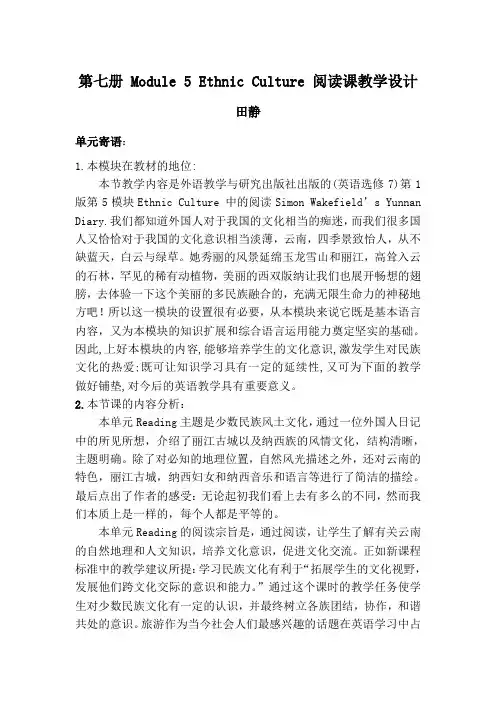
第七册 Module 5 Ethnic Culture 阅读课教学设计田静单元寄语:1.本模块在教材的地位:本节教学内容是外语教学与研究出版社出版的(英语选修7)第1版第5模块Ethnic Culture 中的阅读Simon Wakefield’s Yunnan Diary.我们都知道外国人对于我国的文化相当的痴迷,而我们很多国人又恰恰对于我国的文化意识相当淡薄,云南,四季景致怡人,从不缺蓝天,白云与绿草。
她秀丽的风景延绵玉龙雪山和丽江,高耸入云的石林,罕见的稀有动植物,美丽的西双版纳让我们也展开畅想的翅膀,去体验一下这个美丽的多民族融合的,充满无限生命力的神秘地方吧!所以这一模块的设置很有必要,从本模块来说它既是基本语言内容,又为本模块的知识扩展和综合语言运用能力奠定坚实的基础。
因此,上好本模块的内容,能够培养学生的文化意识,激发学生对民族文化的热爱;既可让知识学习具有一定的延续性,又可为下面的教学做好铺垫,对今后的英语教学具有重要意义。
2.本节课的内容分析:本单元Reading主题是少数民族风土文化,通过一位外国人日记中的所见所想,介绍了丽江古城以及纳西族的风情文化,结构清晰,主题明确。
除了对必知的地理位置,自然风光描述之外,还对云南的特色,丽江古城,纳西妇女和纳西音乐和语言等进行了简洁的描绘。
最后点出了作者的感受:无论起初我们看上去有多么的不同,然而我们本质上是一样的,每个人都是平等的。
本单元Reading的阅读宗旨是,通过阅读,让学生了解有关云南的自然地理和人文知识,培养文化意识,促进文化交流。
正如新课程标准中的教学建议所提:学习民族文化有利于“拓展学生的文化视野,发展他们跨文化交际的意识和能力。
”通过这个课时的教学任务使学生对少数民族文化有一定的认识,并最终树立各族团结,协作,和谐共处的意识。
旅游作为当今社会人们最感兴趣的话题在英语学习中占有非常重要的位置。
所以少数民族文化作为旅游的一个重要组成部分在本模块有所渗透也是一个非常贴近生活,具有时代性,可挖掘性的教学主题。
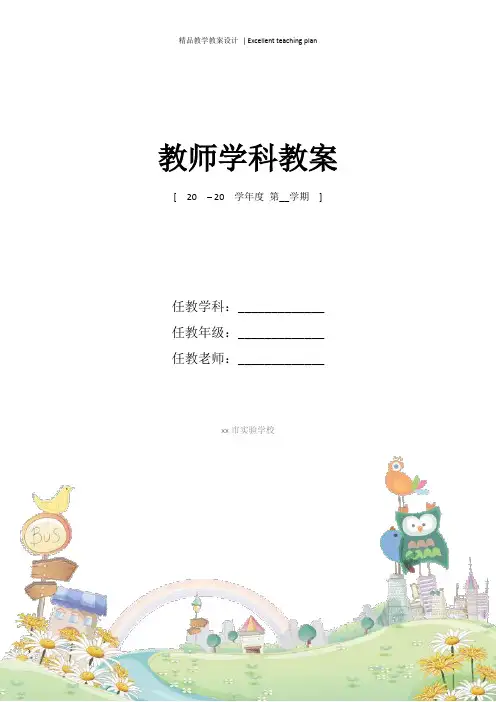
教师学科教案[ 20 – 20 学年度第__学期]任教学科:_____________任教年级:_____________任教老师:_____________xx市实验学校Unit 7 How much are these socks?Section A心心心心 心心心心心心心本本本本本本本本本本本本本本本本本本本本本本本本本本本本本本本本本本“本本本本本本本”本本本本本本本本本本本本本本本本本本本本本本本本本本本本本本本本本本本本本本本本本本本本本本本本本本SectionA本本本本“本本”本本本本本本本本本本本10本本本本本本8本本本本本本本本本本4本本本本本本本本本本本本本本本本本本本本本本本本how much本本本本本本本本本本本本本本本本本本本本本本本本本本本本本本心心心心本本本本本本Important words本much, sock, Tshirt, shorts, sweater, trousers, shoes, skirt, dollar, big, small, short, long, woman, need, look, pair, takeImportant phrase本look niceImportant sentences本1. —How much is this Tshirt本 —It’s seven dollars.2. —How much are these socks本 —They’re two dollars.3. —Can I help you本—Yes, please.4. —Here you are.—Thank you.本本本本本本本本本本本本本本本本本本本本,本本本本本本本本本本本,本本本本本本本本本本本本本本本本本本本本本本本本本本本本本本本本本本本本本本本本本本本本本本本本本本本本本本本本本本本本本本本本本本本本本本本本本本本本本本本本本本本本本本本本本本本本本本本本本本本本本本本本本本本本本本本本本本本本本本本本本本本本本本本本本本本本本本本本本本本本本本本本本心心心心心本本本本本本1. 通过听、说、读的教学活动,让学生掌握表示衣服的英语名称以及描述衣服的形容词。
人教版小学英语第七册Unit4 I have a pen pal PartB Read and write组内课教学设计西乡县城北小学李慧【学习内容分析】本节课是一节新授课,内容是PEP教材六年级上册Uni4 I have a pen pal第五课时Read and write。
需要掌握一些新的单词,更重要的是学会小组合作解决问题,并掌握一定的阅读技巧。
【学情分析】六年级的学生已经学习英语四年了,有了一定的英语基础,本单元主要内容,同学们并不陌生,他们在生活中经常询问和描述他人的兴趣和爱好,因此对他们来说并不难以掌握。
重点是掌握一般现在时的简单用法。
【学习目标】知识与技能:1能够听说认读单词shall,goal,join等。
2.能够听懂,读懂并内化Read and write的内容,并能仿写一片纳新布告。
3.能够掌握良好的阅读策略,积极大胆地尝试写作,并能提高自主学习能力。
过程与方法:Warm-up---Perview---Presentation。
情感态度与价值观:培养学生积极运用所学语言进行表达与交流的能力,培养学生积极思考你,乐于和他人分享信息。
【学习重点】能够听懂,读懂并内化Read and write的内容,并掌握基本的阅读策略。
【学习难点】学生能够能够提高阅读技巧,掌握基本阅读策略,能够大胆尝试,仿写一篇纳新公告,培养基础英文写作能力。
【教法学法】教法:本课运用了情景教学法、愉快教学法、全身反应法、直观教学法等。
学法:本课教学从引导学生复习旧知识,循序渐进地达到学习目标,整个教学体现全员参与,体现合作探究,体现生活实践,在活动中开始,在情景中操练,在运用中创新,充分发挥学生的自主性,创造性。
利用上节课学习的新单词,引导学生学习和理解对话。
【学习过程】教学设计:Step1 Warming-up &revision1.师生共同演唱自编chant。
I go,you go,he goes.I do,you do,he does.I read,you read,he reads.I cook,we cook,she cooks.I play,we play,she plays.I like,we like,she likes.2.Talking Show。
教师学科教案[ 20 – 20 学年度第__学期]
任教学科:_____________ 任教年级:_____________ 任教老师:_____________
xx市实验学校
小学英语人教版第七册阅读课教学设计
1、教学内容:小学英语人教版Book 7 Recycle 1 Let’s read (复习课)
2、教学目标:
结果性目标理解Let’s read部分的对话内容并能做相应的练习
朗读Let’s r ead部分的对话
掌握表达行走方式、某地位置、某人计划打算的主要问答句式
体验性目标对英语学习喜爱的情感体验、对家乡热爱的情感体验
获得成功,具有学习和生活中的主动精神和用英语表述自我的欲望
英语信息记忆方法的掌握
交流合作的愉悦体验
信息资料的收集和处理
3、教学重点:
(1)帮助学生读懂P41 Let’s read 部分。
(2)复习主要句型:What a re you going to do? How do you go (get )there? Where is …?及其应答。
并教会学生在相应的生活情景中运用三个主要句型。
4、教学难点:
(1)帮助学生理解文章中介绍Zhang Peng’s grandparents’ home所在位置和行走路线的一段话,帮助学生学会如何描述行走路线。
(2)通过合理的教学设计,使学生对前三单元的重点句型加固掌握并且有所
深化。
5、教具准备:多媒体课件、GOGO拼图
6、教学步骤:
(1)热身
看一段关于GOGO的影片, 思考:What is Gogo going to do?
(2)复习主要句型(设计浅显的情景对话,先对三组主要句型逐个突破。
)句型1:What are you going to do?
* Gogo is going to the beach. What are you going to do?
What are you going to do after school? (答问形式进行)
*What are you going to do this weekend?(全班话题讨论形式进行)
I have a nice picture for you. Do you want to see it? Let’s talk.
教师在学生讨论过程中,根据学生的发言质量把课件中的一幅图逐步打开,讨论结束后出现一个小男孩背着书包和小鸟在对话的情景。
*What is he going to do? (同桌讨论,看图猜测小男孩要去做什么?)
*Read and answer: (设计对话,提供信息,让学生通过阅读了解小男孩
的真实计划。
)
Bird: Hi! What are you going to do?
Peter: I’m g oing to the bookstore. I want to buy some b ooks.
句型2:Where is the bookstore?
*(出示地图)Look! Where is the bookstore?
*If Peter starts from here, how can he get to the bookstore?
How many ways can lead him to the book store?(四人小组讨论)
(学生讨论到指定的书店有几种行走路线。
)
*Which way does Peter choose? Let’s read. (阅读对话,了解小
男孩选择的是哪条路。
)
Bird: How do you get there?
Peter: I get there on foot.
Go straight, turn left at the traffic lights in front
of the cinema.
Then go east for about three minutes.
The bookstore is on the right.
Bird: Can you go by bus?
Peter: Yes, I can. But I like to walk there.
句型3:How do you get to…?
*Peter goes to the bookstore on foot . Can he go by bus? Do we
have any good
bookstores in Ningbo? How do you get there? (讨论宁波有哪些好的书店,如何去那里。
)
*Let’s say: I go to the bookstore ….(by bike ,by bus, by car…)
*Let’s say: … go to …by (on)….(演示课件,学生每说一个句子就
能帮助小女孩前进一步,最后来到她的奶奶家.)
(3)阅读再理解。
Let’s read the dialogue again and try to answer the questions.
Bird: Hi! What are you going to do?
Peter: I’m going to the bookstore.
I want to buy some books.
Bird: How do you get there?
Peter: I get there on foot. Go s traight, turn left at the traffic lights in front of the cinema, then go east for about three minutes.
The book- store is on the right.
Bird: Can you go by bus ?
Peter: Yes, I can. But I like to walk there.
Questions: 1. What is Peter going to do?
2. How does he get there?
3. Can he go by bus?
(4)指导阅读对话(引出课本中的对话。
对借助课文阅读材料对重点知识
进行综合运用,获得信息。
)
Listen to another dialogue and try to answer the questions:
①What is Zhang Peng going to do ?
②How does he go there?
③What is Mike going to do ?
④Are they going together?
When are they going?
Read and do the exercises. (中间穿插拼图游戏,进行激励。
通过五个练习题拼得Gogo的形象。
)
(5)卡通歌曲欣赏:Where are we going?
(6)拓展任务及课后作业:
根据地图中的标示,向外宾介绍其中一处景点,并说明行走路线。
(教师在课内作示范表演,请学生们课后作练习,这一活动将作为课本知识与生活实际或未来生活相联结的桥梁)。